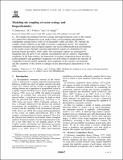Modeling the coupling of ocean ecology and biogeochemistry
Author(s)
Dutkiewicz, Stephanie; Bragg, Jason G.; Follows, Michael J
DownloadDutkiewicz-2009-Modeling the coupling.pdf (733.7Kb)
PUBLISHER_POLICY
Publisher Policy
Article is made available in accordance with the publisher's policy and may be subject to US copyright law. Please refer to the publisher's site for terms of use.
Terms of use
Metadata
Show full item recordAbstract
We examine the interplay between ecology and biogeochemical cycles in the context of a global three-dimensional ocean model where self-assembling phytoplankton communities emerge from a wide set of potentially viable cell types. We consider the complex model solutions in the light of resource competition theory. The emergent community structures and ecological regimes vary across different physical environments in the model ocean: Strongly seasonal, high-nutrient regions are dominated by fast growing bloom specialists, while stable, low-seasonality regions are dominated by organisms that can grow at low nutrient concentrations and are suited to oligotrophic conditions. In the latter regions, the framework of resource competition theory provides a useful qualitative and quantitative diagnostic tool with which to interpret the outcome of competition between model organisms, their regulation of the resource environment, and the sensitivity of the system to changes in key physiological characteristics of the cells.
Date issued
2009-11Department
Massachusetts Institute of Technology. Center for Global Change Science; Massachusetts Institute of Technology. Department of Civil and Environmental Engineering; Massachusetts Institute of Technology. Department of Earth, Atmospheric, and Planetary SciencesJournal
Global Biogeochemical Cycles
Publisher
American Geophysical Union (AGU)
Citation
Dutkiewicz, S., M. J. Follows, and J. G. Bragg. “Modeling the Coupling of Ocean Ecology and Biogeochemistry.” Global Biogeochemical Cycles 23, no. 4 (November 3, 2009): n/a–n/a. © 2009 American Geophysical Union
Version: Final published version
ISSN
08866236